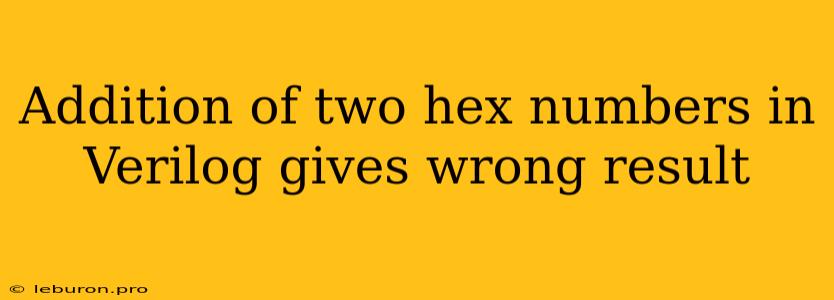The Verilog language is widely used for designing and simulating digital circuits. One common task in Verilog is performing arithmetic operations, including addition. While adding two hexadecimal numbers in Verilog may seem straightforward, there are some nuances that can lead to incorrect results. This article will delve into the reasons why you might encounter an incorrect result when adding two hex numbers in Verilog and provide solutions to ensure accurate calculations.
Understanding Hexadecimal Numbers in Verilog
Hexadecimal numbers, often represented using the prefix "0x", are commonly used in Verilog to represent binary data. Each hexadecimal digit corresponds to a group of four binary digits (bits). For instance, the hexadecimal number 0xA is equivalent to the binary number 1010. When performing arithmetic operations with hexadecimal numbers, it's crucial to understand how Verilog interprets and manipulates these values.
Common Causes for Incorrect Addition Results
Several factors can contribute to incorrect addition results when working with hexadecimal numbers in Verilog:
1. Data Type Mismatch
One of the most common errors occurs when the data types of the operands being added are incompatible. Verilog uses different data types to represent signals, such as wire, reg, and integer. These data types have different storage sizes and ranges. If you attempt to add two hexadecimal numbers represented by different data types, the result may be inaccurate. For example, adding a reg variable with a range of 8 bits to an integer variable can produce unexpected results.
2. Overflow
Overflow occurs when the result of an addition exceeds the maximum value that the data type can represent. For instance, adding two 8-bit hexadecimal numbers might produce a 9-bit result. If the result is stored in an 8-bit register, the most significant bit will be lost, leading to an incorrect value.
3. Signed vs. Unsigned Numbers
Verilog differentiates between signed and unsigned numbers. Signed numbers use the most significant bit to represent the sign (0 for positive, 1 for negative). When adding signed and unsigned numbers, the result may be incorrect if the interpretation of the sign bit is not handled properly.
Debugging and Troubleshooting
When encountering incorrect addition results, it's essential to systematically troubleshoot the issue to identify the root cause. Here are some steps you can take:
-
Verify Data Types: Ensure that the data types of the operands being added are compatible. If necessary, convert the operands to the same data type before performing the addition.
-
Check for Overflow: If overflow is suspected, consider using a larger data type to accommodate the result. Alternatively, you can implement an overflow detection mechanism to flag cases where overflow occurs.
-
Analyze Sign Bit: If you are dealing with signed numbers, verify that the sign bit is being handled correctly during the addition operation.
-
Use Verilog's Built-in Functions: Utilize Verilog's built-in functions for addition, such as
+or$plus. These functions handle data type conversions and overflow automatically, reducing the risk of errors. -
Simulate and Inspect: Use a Verilog simulator to test your code and inspect the intermediate results. Analyze the values of the operands and the output to identify potential errors.
Example Scenario
Let's consider a simple example to illustrate the concept of overflow during addition:
reg [7:0] a, b, sum;
initial begin
a = 8'hFF; // a = 255
b = 8'h01; // b = 1
sum = a + b; // sum should be 256 (0x100) but will overflow
$display("sum = 0x%h", sum); // Expected output: sum = 0x00
end
In this example, we are adding two 8-bit hexadecimal numbers a and b. The expected sum is 0x100, which requires 9 bits to represent. However, since sum is declared as an 8-bit register, the result overflows, and the most significant bit is lost. Consequently, the value of sum will be 0x00, which is incorrect.
Conclusion
Adding two hex numbers in Verilog can lead to incorrect results if certain factors are not considered. Understanding data types, overflow conditions, and signed vs. unsigned numbers is crucial for ensuring accurate calculations. By carefully examining your code, using appropriate data types, and implementing overflow detection mechanisms, you can avoid common pitfalls and achieve accurate results when performing addition operations in Verilog. Remember to thoroughly test your code using a Verilog simulator to validate its correctness and identify potential errors.
